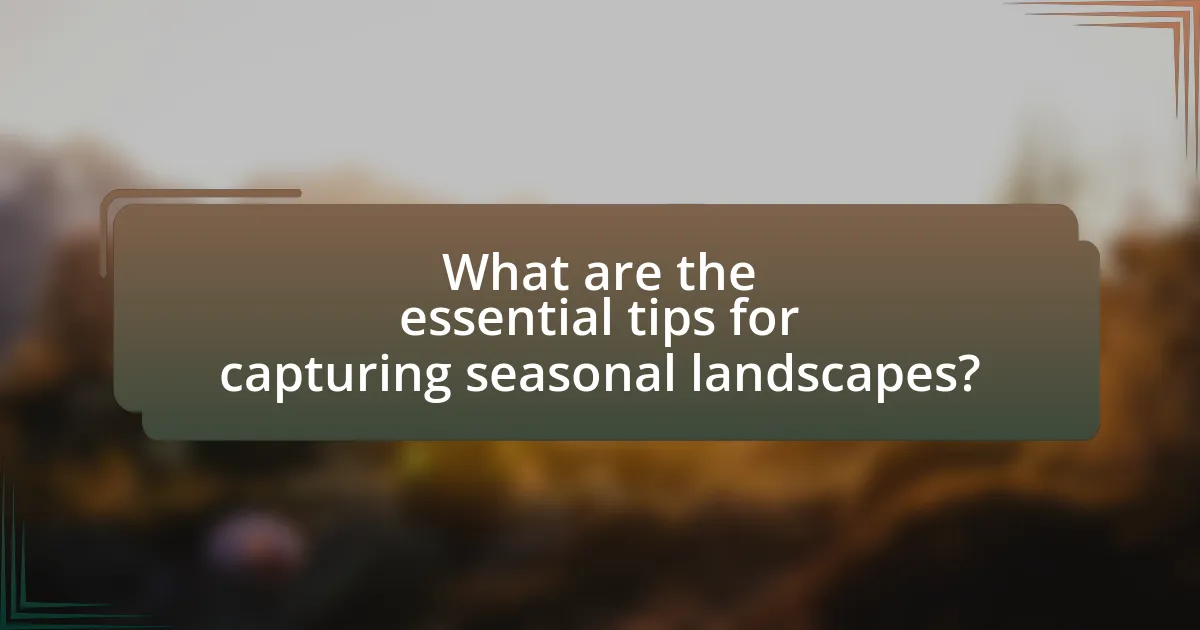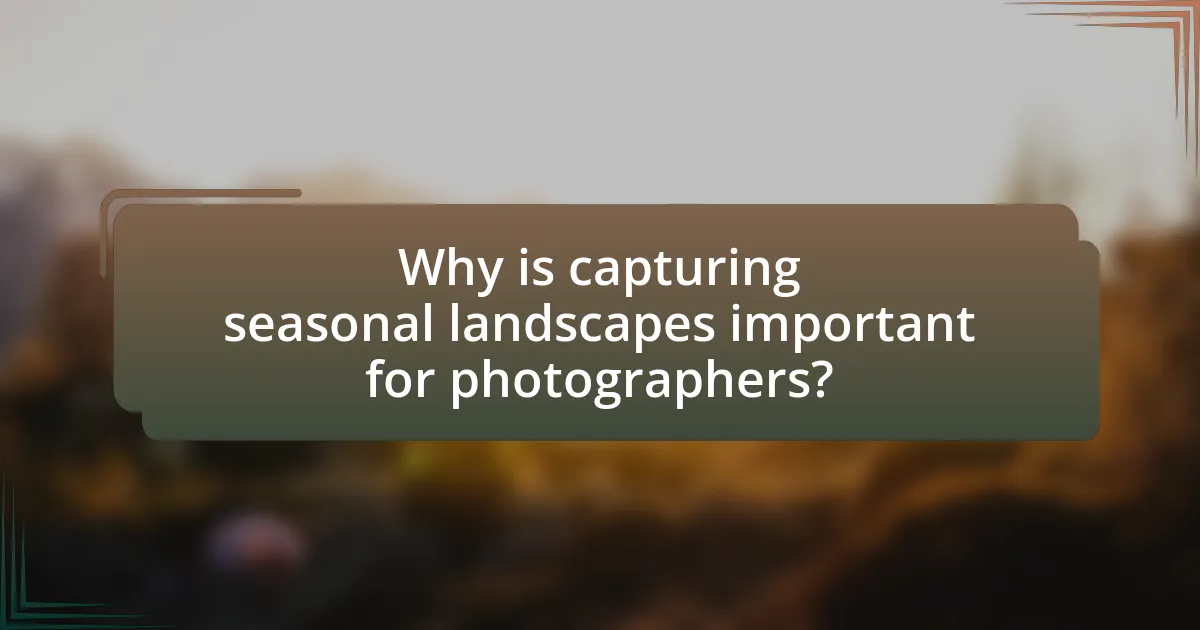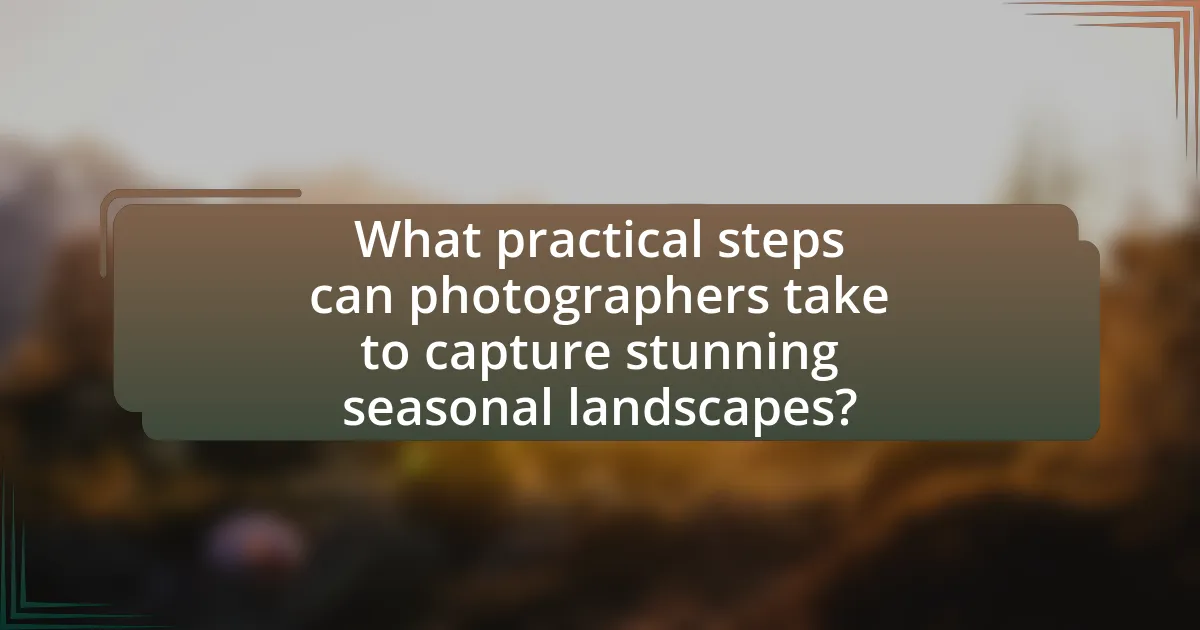The article focuses on essential tips for capturing seasonal landscapes, emphasizing the importance of timing, lighting, and composition to enhance photographic quality. It discusses how understanding seasonal changes can improve the aesthetic appeal and emotional impact of landscape images, detailing specific elements that vary with each season, such as light quality and color palettes. Additionally, the article outlines effective composition strategies, the significance of seasonal colors in influencing mood, and practical steps photographers can take to prepare for shoots. It also addresses common challenges faced during seasonal photography and offers editing techniques to enhance the final images, ultimately highlighting the competitive advantages of mastering seasonal landscape photography for building a distinctive portfolio and attracting clients.

What are the essential tips for capturing seasonal landscapes?
To effectively capture seasonal landscapes, photographers should focus on timing, lighting, and composition. Timing is crucial; for instance, capturing autumn foliage is best done during peak color weeks, which can vary by region. Lighting plays a significant role; the golden hour, shortly after sunrise or before sunset, enhances colors and adds depth to images. Composition techniques, such as the rule of thirds and leading lines, help create visually appealing photographs. Additionally, using a tripod stabilizes the camera for sharper images, especially in low light conditions. These strategies are supported by the fact that many professional photographers emphasize the importance of these elements in their work, leading to more compelling seasonal landscape photography.
How can understanding seasonal changes enhance landscape photography?
Understanding seasonal changes enhances landscape photography by allowing photographers to capture the unique characteristics and moods of different times of the year. Each season offers distinct lighting, colors, and weather conditions that can dramatically alter the appearance of a landscape. For instance, autumn provides vibrant foliage, while winter can create stark, minimalist scenes with snow. Research indicates that the quality of natural light varies with the seasons, affecting the overall composition and emotional impact of photographs. By recognizing these seasonal variations, photographers can plan their shoots to align with optimal conditions, thereby improving the aesthetic quality and marketability of their work.
What specific elements change with each season that affect photography?
The specific elements that change with each season and affect photography include light quality, color palettes, weather conditions, and landscape features. In spring, the light is softer, and vibrant colors emerge from blooming flowers, enhancing contrast in images. Summer offers bright, harsh light and lush greenery, which can create high saturation but may also lead to overexposed highlights. Autumn introduces warm tones and dramatic skies, providing rich color contrasts, while winter presents a stark, minimalist landscape with low light and potential snow reflections, altering exposure settings. Each seasonal change impacts the photographer’s approach to composition, exposure, and color balance, necessitating adjustments to capture the essence of the landscape effectively.
How do seasonal colors influence the mood of landscape images?
Seasonal colors significantly influence the mood of landscape images by evoking specific emotional responses associated with each season. For instance, vibrant autumn hues like orange and red can create feelings of warmth and nostalgia, while the cool blues and whites of winter landscapes often evoke calmness and serenity. Research indicates that color psychology plays a crucial role in how viewers perceive images; warm colors tend to stimulate energy and excitement, whereas cool colors are linked to tranquility and relaxation. This understanding allows photographers to strategically use seasonal colors to enhance the emotional impact of their landscape images, ultimately providing a competitive edge in visual storytelling.
What techniques can improve the quality of seasonal landscape photos?
To improve the quality of seasonal landscape photos, photographers should utilize techniques such as optimal lighting, composition, and post-processing. Optimal lighting, particularly during the golden hours of sunrise and sunset, enhances colors and shadows, making landscapes more vibrant. Composition techniques like the rule of thirds help create balanced and engaging images, while leading lines can draw the viewer’s eye into the scene. Post-processing, including adjustments to contrast, saturation, and sharpness, can further enhance the final image quality. These techniques are supported by studies showing that well-composed and well-lit images significantly increase viewer engagement and aesthetic appeal.
How does lighting impact the capture of seasonal landscapes?
Lighting significantly impacts the capture of seasonal landscapes by influencing color, mood, and texture. Different times of day and weather conditions create varying light qualities; for instance, golden hour light enhances warm tones in autumn foliage, while overcast skies can saturate colors and soften shadows, providing a different aesthetic. Studies show that the angle of sunlight affects the visibility of details in landscapes, with low angles during sunrise and sunset creating longer shadows that add depth and dimension. This understanding of light dynamics is crucial for photographers aiming to highlight the unique characteristics of each season effectively.
What composition strategies work best for seasonal landscapes?
Effective composition strategies for seasonal landscapes include the use of leading lines, framing, and the rule of thirds. Leading lines guide the viewer’s eye through the image, enhancing depth and perspective, while framing elements like trees or arches can create a sense of context and focus. The rule of thirds helps in placing key elements off-center, making the composition more dynamic and engaging. These strategies are supported by the principles of visual perception, which suggest that well-structured compositions are more appealing and can evoke stronger emotional responses from viewers.

Why is capturing seasonal landscapes important for photographers?
Capturing seasonal landscapes is important for photographers because it allows them to showcase the unique beauty and characteristics of each season, enhancing their portfolio and attracting diverse clientele. Seasonal changes provide distinct color palettes, lighting conditions, and atmospheric effects that can significantly influence the mood and composition of photographs. For instance, autumn foliage offers vibrant reds and oranges, while winter landscapes can create serene, minimalist scenes. This variety not only enriches a photographer’s work but also meets the demand for seasonal imagery in commercial markets, such as tourism and advertising, where specific seasonal themes are often sought after.
How can seasonal landscapes differentiate a photographer’s portfolio?
Seasonal landscapes can differentiate a photographer’s portfolio by showcasing a diverse range of colors, textures, and moods that reflect the unique characteristics of each season. This variety not only attracts potential clients but also demonstrates the photographer’s versatility and ability to capture the essence of different environments throughout the year. For instance, spring may highlight vibrant blooms, summer can showcase lush greenery, autumn offers rich, warm tones, and winter presents stark, serene scenes. By including these seasonal variations, photographers can create a more compelling and visually engaging portfolio that stands out in a competitive market.
What unique storytelling opportunities do seasonal landscapes provide?
Seasonal landscapes provide unique storytelling opportunities by showcasing the dynamic changes in nature that reflect different moods, themes, and narratives. Each season offers distinct visual elements; for instance, spring symbolizes renewal and growth with blooming flowers, while autumn evokes nostalgia and transition through vibrant foliage. These seasonal characteristics can be used to convey specific emotions or messages in storytelling, enhancing the depth and relatability of the narrative. Furthermore, the varying light conditions and weather patterns associated with each season can create dramatic backdrops that amplify the visual impact of the story being told.
How does seasonal photography attract specific audiences or clients?
Seasonal photography attracts specific audiences or clients by aligning visual content with their interests and emotional connections tied to particular times of the year. For instance, families often seek autumn-themed photography for holiday cards, while couples may look for springtime engagement shoots that capture blooming landscapes. This targeted approach is supported by market research indicating that 70% of consumers are more likely to engage with seasonal content that resonates with their personal experiences and traditions. By leveraging seasonal themes, photographers can effectively cater to these distinct client needs, enhancing their appeal and driving business growth.
What are the competitive advantages of mastering seasonal landscape photography?
Mastering seasonal landscape photography provides competitive advantages such as enhanced creativity, unique portfolio diversity, and increased marketability. Photographers who capture landscapes across different seasons can showcase a broader range of skills and artistic vision, appealing to various client needs. For instance, a study by the Professional Photographers of America indicates that diverse portfolios attract 30% more clients compared to those with limited seasonal representation. Additionally, seasonal photography allows for the exploration of different lighting conditions and color palettes, which can lead to distinctive images that stand out in a saturated market. This mastery not only elevates a photographer’s artistic credibility but also positions them as experts in capturing the beauty of nature throughout the year, ultimately leading to greater business opportunities and client engagement.
How can seasonal landscapes enhance marketing efforts for photographers?
Seasonal landscapes can significantly enhance marketing efforts for photographers by providing unique and visually appealing content that attracts potential clients. Each season offers distinct colors, lighting, and natural elements that can be leveraged to create compelling imagery, which can differentiate a photographer’s portfolio in a competitive market. For instance, autumn foliage can evoke emotions of warmth and nostalgia, while winter scenes can convey tranquility and beauty. According to a study by the American Society of Photographers, seasonal imagery can increase engagement on social media platforms by up to 60%, demonstrating its effectiveness in capturing audience attention and driving interest in photography services.
What role does seasonal photography play in building a brand identity?
Seasonal photography plays a crucial role in building a brand identity by visually aligning a brand with the emotions and themes associated with different seasons. This alignment enhances brand recognition and fosters a deeper emotional connection with the audience. For instance, brands that utilize seasonal imagery can evoke feelings of warmth and nostalgia during winter holidays or freshness and renewal in spring, which can lead to increased customer engagement and loyalty. Research indicates that 60% of consumers are more likely to engage with brands that reflect seasonal themes in their marketing efforts, demonstrating the effectiveness of this strategy in reinforcing brand identity.

What practical steps can photographers take to capture stunning seasonal landscapes?
Photographers can capture stunning seasonal landscapes by planning their shoots around the best times for lighting and weather conditions. For instance, shooting during the golden hour, shortly after sunrise or before sunset, enhances colors and shadows, making landscapes more visually appealing. Additionally, understanding seasonal changes, such as foliage patterns in autumn or blooming flowers in spring, allows photographers to select optimal locations and times for capturing vibrant scenes. Research indicates that the quality of natural light significantly influences the aesthetic appeal of landscape photography, with studies showing that images taken during these times receive higher viewer engagement.
How can photographers prepare for seasonal landscape shoots?
Photographers can prepare for seasonal landscape shoots by researching the specific seasonal changes in their chosen location, including weather patterns, flora, and fauna. Understanding these elements allows photographers to plan their shoots for optimal lighting and composition, which is crucial for capturing the essence of the season. For instance, autumn foliage peaks at different times depending on the region, so knowing the local peak times can significantly enhance the quality of the photographs. Additionally, photographers should scout locations in advance to identify the best vantage points and compositions, ensuring they are ready to capture the landscape at its most picturesque moments.
What gear is essential for capturing seasonal landscapes effectively?
Essential gear for capturing seasonal landscapes effectively includes a high-quality DSLR or mirrorless camera, a versatile lens (preferably a wide-angle lens), a sturdy tripod, and polarizing filters. A high-quality camera allows for better image quality and detail, while a wide-angle lens captures expansive scenes typical of seasonal landscapes. A sturdy tripod ensures stability for long exposures and low-light conditions, which are common in seasonal photography. Polarizing filters enhance colors and reduce glare, making them particularly useful for capturing vibrant autumn foliage or reflective winter scenes.
How can photographers plan their shoots around seasonal events or changes?
Photographers can plan their shoots around seasonal events or changes by creating a detailed calendar that aligns with local festivals, natural phenomena, and seasonal weather patterns. This approach allows photographers to capture unique moments, such as cherry blossoms in spring or autumn foliage, which are time-sensitive and visually striking. For instance, the National Park Service provides seasonal guides that highlight peak viewing times for various landscapes, helping photographers schedule their shoots effectively. Additionally, utilizing weather apps and local event calendars can ensure that photographers are prepared for optimal lighting and conditions, enhancing the quality of their images.
What are some common challenges in capturing seasonal landscapes?
Common challenges in capturing seasonal landscapes include rapidly changing weather conditions, varying light quality, and the need for precise timing to capture peak seasonal colors. Weather can shift unexpectedly, affecting visibility and mood, while light quality changes throughout the day, influencing the appearance of colors and shadows. Additionally, capturing the optimal moment for seasonal changes, such as autumn foliage or spring blooms, requires careful planning and knowledge of local flora and fauna, as these events can be fleeting and dependent on specific climatic conditions.
How can photographers overcome weather-related obstacles during shoots?
Photographers can overcome weather-related obstacles during shoots by utilizing appropriate gear and planning for variable conditions. For instance, using weather-sealed cameras and lenses protects equipment from rain and moisture, while employing lens hoods can reduce lens flare caused by bright sunlight. Additionally, checking weather forecasts and being flexible with shooting schedules allows photographers to capture optimal lighting and conditions, as studies show that the golden hour significantly enhances landscape photography. By preparing for unexpected changes, such as carrying portable shelters or using reflectors, photographers can adapt to the environment and maintain the quality of their work.
What strategies can help in dealing with changing light conditions?
To effectively deal with changing light conditions, photographers should utilize techniques such as bracketing exposures, using neutral density filters, and adjusting the white balance. Bracketing exposures allows for capturing multiple images at different exposure levels, ensuring that at least one image is well-exposed despite fluctuating light. Neutral density filters reduce the intensity of light entering the lens, enabling longer exposure times without overexposing the image, which is particularly useful during bright conditions. Adjusting the white balance helps to maintain accurate color representation as light changes throughout the day, ensuring that the final image reflects the true colors of the landscape. These strategies are essential for maintaining image quality and achieving desired artistic effects in varying light conditions.
What are the best practices for editing seasonal landscape photos?
The best practices for editing seasonal landscape photos include adjusting exposure, enhancing colors, and applying selective sharpening. Adjusting exposure ensures that the image captures the right amount of light, which is crucial for showcasing seasonal elements like autumn leaves or winter snow. Enhancing colors can involve increasing saturation and vibrancy to make seasonal hues pop, particularly in spring and summer landscapes. Selective sharpening focuses on key areas of the image, such as the foreground or specific details, to draw attention and create depth. These practices are supported by the fact that well-edited landscape photos can significantly improve visual appeal and engagement, making them more competitive in photography markets.
How can post-processing enhance the seasonal elements in photographs?
Post-processing can enhance the seasonal elements in photographs by adjusting colors, contrast, and sharpness to better reflect the mood and characteristics of each season. For instance, increasing saturation can make autumn leaves appear more vibrant, while adjusting the white balance can create a cooler tone for winter scenes. Techniques such as selective editing allow photographers to emphasize specific seasonal features, like highlighting blooming flowers in spring or enhancing the golden hues of summer sunsets. These adjustments not only improve the visual appeal but also help convey the intended atmosphere and emotion associated with each season, making the photographs more engaging and impactful.
What editing techniques are most effective for different seasons?
Effective editing techniques for different seasons include color grading, contrast adjustments, and selective sharpening. For spring, enhancing greens and pastels through color grading can evoke freshness, while increasing contrast highlights the vibrancy of blooming flowers. In summer, boosting saturation and warmth can amplify the brightness of sunny landscapes. For autumn, adjusting hues to emphasize oranges and reds, along with softening highlights, creates a cozy atmosphere. In winter, reducing saturation and increasing contrast can enhance the starkness of snowy scenes, while adding a slight blue tint can evoke a cold feel. These techniques are supported by the principles of color theory and visual perception, which indicate that specific color adjustments can significantly impact the emotional response of viewers.
